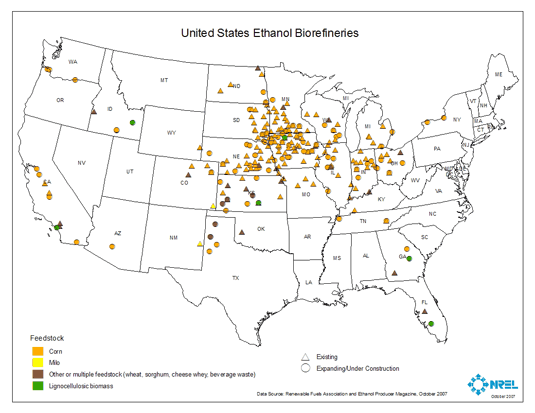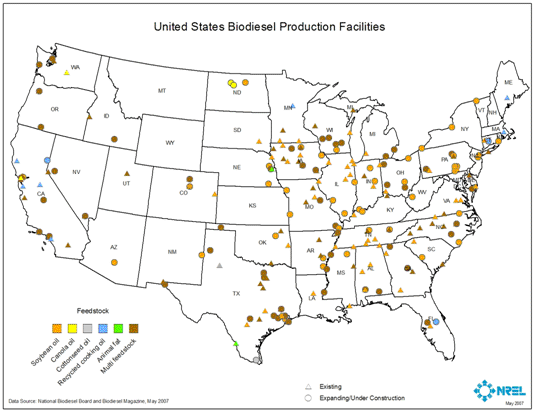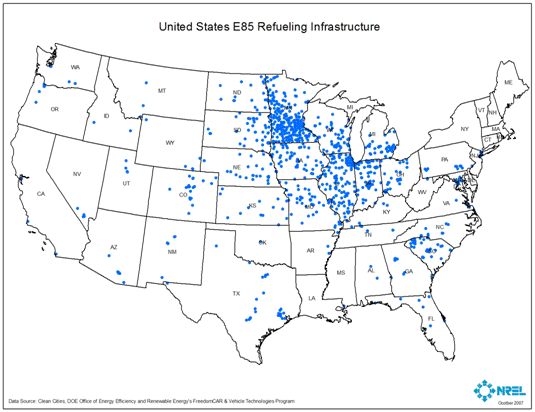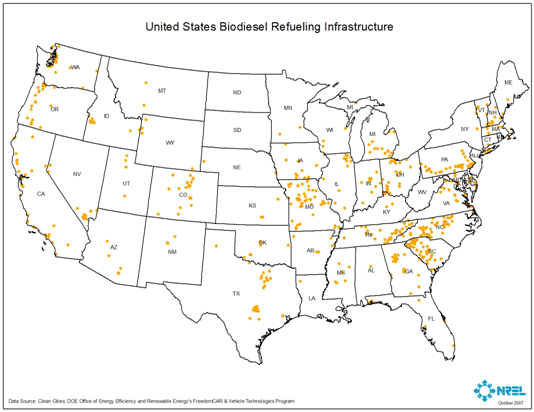United States Biofuels Activities

Here you'll find information about the United States' work in biofuels. Learn more about its:
Background
Biofuels in the United States provide a significant economic stimulus in rural areas. Various factors contribute to the industry growth including concerns about methyl tertiary-butyl ether (MTBE) contamination, renewable fuels standards and other federal and state policies, sustained high oil and gas prices, and a need to diversify the fuel supply with domestic, cleaner products.
Production
Annual U.S. ethanol production increased from insignificant quantities in the 1970s to approximately 21,000 million liters in 2006. Most of the ongoing and projected biofuels expansion in the United States is for ethanol, but biodiesel is expanding as well, from negligible quantities in 2000 to about 750,000 tonnes in 2006.
According to the Renewable Fuels Association, there are about 135 existing ethanol biorefineries with a total capacity of 28,000 million liters per year (December 2007). Seventy-four plants with approximately 23,000 million liters capacity are under construction or expansion. There are six commercial lignocellulosic ethanol plants under construction. Four of them (BlueFire Ethanol Inc., Broin Companies, Iogen Biorefinery Partners, and Abengoa Bioenergy) will employ biochemical conversion process; and two (Range Fuels and ALICO Inc.) will produce ethanol via thermo-chemical conversion process. When fully operational, the biorefineries are expected to produce more than 130 million gallons (492 million liters) of ethanol per year. A map illustrating the locations of these facilities is provided below in Figure 1.
Figure 1. U.S. Ethanol Biorefineries

According to the National Biodiesel Board, there are 165 operating biodiesel production facilities with a total capacity of 7,000 million liters (September 2007). Eighty-four plants are under construction or expansion with approximately 5,000 million liters capacity. A map illustrating the existing and under construction biodiesel production facilities is provided below in Figure 2.
Figure 2. U.S. Biodiesel Production Facilities

Feedstock
Today, nearly all ethanol in the United States is made from corn grain. The increase in the use of corn for ethanol nearly doubles the production each year. In 2006/2007, the increase was 250 million bushels; in 2007/2008, the increase is 500 million bushels. In 2008/2009, the increase for the crop year is expected to be 1,000 million bushels. The U.S. Department of Agriculture (USDA) predicts that, in 2008, the total use of corn for ethanol will approach 30% of the entire U.S. crop. The rapid expansion of the corn-growing sector produced an unprecedented demand shock to the world agricultural system. The price of corn is about 75% higher from 2006 to 2007, and the higher price of corn has consequently increased the price of all other grains worldwide.
Ethanol provides a rapidly growing environment for other grains, such as sorghum and milo. Ethanol production consumed approximately 26% of the nation's sorghum crop in 2006.
In the future, corn may cease to be the main feedstock for U.S. ethanol production if lignocellulosic biomass (agricultural and forestry residues, dedicated energy crops) is successfully developed and commercialized as an alternative. A report by the U.S. DOE and USDA (Biomass as Feedstock for a Bioenergy and Bioproducts Industry: Technical Feasibility of a Billion Ton Annual Supply, 2005) suggests that, by the middle of the 21st century, the United States should be able to produce 1,300 million US tons of biomass feedstock per year, enough to displace approximately 30% of its current petroleum consumption.
Approximately 90% of biodiesel produced in the United States is made from soybean oil. Some experts estimate that if the biodiesel industry keeps its current momentum, more than 10% of U.S. soybean oil could be used for biodiesel production in the next few years. The United States is the world leader in soybean production with about 87 million tonnes produced in 2006/2007 crop year. Half of this production was exported, which placed the member economy in second place as the largest soybean exporter, after Brazil.
Economics
The following charts show specific economic statistics for the member economy.
| Ethanol | US$/liter |
|---|---|
| From corn | 0.46 - 0.48 |
| From lignocellulosic biomass | 0.53 - 0.66 |
Source: NREL 2007
| Biodiesel | US$/liter |
|---|---|
| From soybeans | 0.39 - 0.79 |
| From used cooking oil | 0.26 - 0.50 |
| From algae | 1.50 – 2.00 |
Source: NREL 2007
Biofuels in Use
Low-level ethanol fuel blends are sold in every state. Nearly one-third of U.S. gasoline now contains up to 10% ethanol to boost octane or meet air quality requirements. All auto manufacturers approve the use of low-level ethanol blends, because these fuels work well in gasoline engines and have no noticeable difference in vehicle performance (U.S. DOE EERE). Ethanol is also widely available in high-level blends such as E85 (85% ethanol/15% gasoline), used to fuel E85-capable vehicles or flexible fuel vehicles (FFVs). According to the Renewable Fuels Association, there are about 190 million liters of E85 consumed in the United States today.
The most common biodiesel blend in the United States is B20 (20% biodiesel and 80% diesel), but lower-level biodiesel blends, such as B2 (2% biodiesel and 98% diesel) and B5 (5% biodiesel and 95% diesel) are becoming increasingly available. Higher blends, or blends beyond B20 such as B100 are currently used by professional fleets. These government and private fleets are equipped with maintenance departments prepared to deal with the cold-weather performance and material concerns associated with higher blends. In comparison, B20 and lower-level blends can be used in nearly all diesel vehicles. The National Biodiesel Board estimated that about 950 million liters of biodiesel was sold in the United States in 2006, much higher than the 284 million liters sold in 2005.
Infrastructure and Vehicles
As of early 2007, nearly 1,200 U.S. fueling stations offered E85. The stations are highly concentrated in the Corn Belt, but are spreading throughout the economy. Figure 3 illustrates the geographic distribution of these stations.
Figure 3. U.S. E85 Refueling Infrastructure

There are about 6 million registered FFVs in the United States, available in a variety of models from U.S. and foreign automakers. More information on the FFVs available in the United States can be found through the Alternative Fuels and Advanced Vehicles Data Center.
Approximately 700 fueling stations offered biodiesel in 2007. The stations are available throughout the United States — Figure 4 shows their distribution.
Figure 4. U.S. Biodiesel Refueling Infrastructure

Trade
In 2006, the phase-out of MTBE in most fuel markets throughout the member economy resulted in an unprecedented increase in ethanol demand. The Renewable Fuels Association (RFA) reports that 2,500 million liters of ethanol were imported in 2006, mostly from Brazil, with small volumes from Central America and the Caribbean (Jamaica, El Salvador, Costa Rica, Trinidad, and Tobago).
EarthFirst Americas Incorporated (EFA) reported twice the import of palm oil-based biodiesel from Ecuador at the end of 2005 and early 2006. The second shipment totals 3 million liters, a substantial increase from the first shipment of 1 million liters. The report was received with a negative reaction by the American Soybean Association (ASA), a trade group representing U.S. soy producers, and called on Congress to establish protectionist measures to block imported biodiesel from competing with the domestic soy-based product.
The U.S. biofuels import market will unlikely grow much in the next few years given the increased domestic production. In fact, some analysts predict that the U.S. biofuels market could become independent of imports in the next one-two years (2008-2010).
Policy
U.S. policy and legislation play a crucial role in the development and use of biofuels. The National Biodiesel Board (NBB) determined that the most pressing issue for the industry in 2007 was public policy. More than quality, distribution, or new markets, the NBB said policy was the issue that would most impact the vitality of the industry.
The Energy Policy Act (EPAct) of 2005 was the first major piece of federal energy legislation since 1992, and it contains a number of policies and incentives to further enhance and encourage the development and production of biofuels, including:
- Establishing a renewable fuel standard (RFS) that mandates all gasoline sold in the United States contain 7.5 billion gallons of renewable fuels by 2012. In 2013, the renewable fuels used should contain 250 million gallons of fuel derived from cellulosic biomass
- Tax incentives for blenders of $0.51/gallon (13.5 cents/liter) for ethanol, and $1/gallon (27 cents/liter) for biodiesel
The DOE's Office of Energy Efficiency and Renewable Energy (EERE) tracks existing federal and state biomass-related policies, along with other legislation that drives the development and deployment of biofuels in the member economy. Additionally, the Alternative Fuels Data Center, sponsored by DOE's Clean Cities Program, provides a listing of state and federal incentives and policies related to alternative fuels.